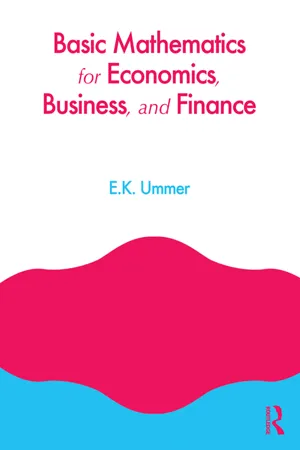
- 484 pages
- English
- ePUB (mobile friendly)
- Available on iOS & Android
Basic Mathematics for Economics, Business and Finance
About this book
This book can help overcome the widely observed math-phobia and math-aversion among undergraduate students in these subjects. The book can also help them understand why they have to learn different mathematical techniques, how they can be applied, and how they will equip the students in their further studies.
The book provides a thorough but lucid exposition of most of the mathematical techniques applied in the fields of economics, business and finance. The book deals with topics right from high school mathematics to relatively advanced areas of integral calculus covering in the middle the topics of linear algebra; differential calculus; classical optimization; linear and nonlinear programming; and game theory.
Though the book directly caters to the needs of undergraduate students in economics, business and finance, graduate students in these subjects will also definitely find the book an invaluable tool as a supplementary reading. The website of the book – ww.emeacollege.ac.in/bmebf – provides supplementary materials and further readings on chapters on difference equation, differential equations, elements of Mathematica®, and graphics in Mathematica®, . It also provides materials on the applications of Mathematica®, as well as teacher and student manuals.
Frequently asked questions
- Essential is ideal for learners and professionals who enjoy exploring a wide range of subjects. Access the Essential Library with 800,000+ trusted titles and best-sellers across business, personal growth, and the humanities. Includes unlimited reading time and Standard Read Aloud voice.
- Complete: Perfect for advanced learners and researchers needing full, unrestricted access. Unlock 1.4M+ books across hundreds of subjects, including academic and specialized titles. The Complete Plan also includes advanced features like Premium Read Aloud and Research Assistant.
Please note we cannot support devices running on iOS 13 and Android 7 or earlier. Learn more about using the app.
Information
Table of contents
- Cover
- Half Title
- Title Page
- Copyright
- Dedication
- Contents
- Preface
- Acknowledgments
- 1. Review of basics
- 2. Linear algebra: vectors and matrices
- 3. Differential calculus
- 4. Classical optimization
- 5. Linear programming
- 6. Nonlinear programming
- 7. Game theory
- 8. Integral calculus
- Notes
- Bibliography
- Index
- Greek alphabet